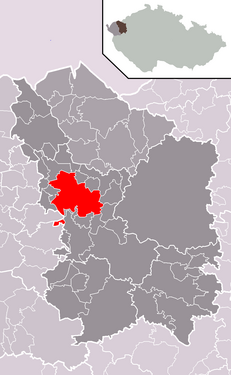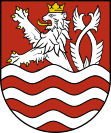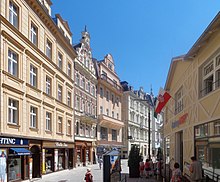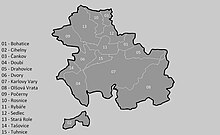Carlsbad
| Karlovy Vary | ||||
|---|---|---|---|---|
|
||||
| Basic data | ||||
| State : |
|
|||
| Historical part of the country : | Bohemia | |||
| Region : | Karlovarský kraj | |||
| District : | Karlovy Vary | |||
| Area : | 5908.272 ha | |||
| Geographic location : | 50 ° 14 ' N , 12 ° 52' E | |||
| Height: | 447 m nm | |||
| Residents : | 48,501 (Jan. 1, 2019) | |||
| Postal code : | 360 01 | |||
| License plate : | K (old: KR, KV) | |||
| traffic | ||||
| Street: | E 49 | |||
| Railway connection: |
Chomutov – Cheb Karlovy Vary – Johanngeorgenstadt Mariánské Lázně – Karlovy Vary |
|||
| Next international airport : | Karlovy Vary Airport | |||
| structure | ||||
| Status: | Statutory city | |||
| Districts: | 15th | |||
| administration | ||||
| Lord Mayor : | Andrea Pfefer-Ferklová (Ano) (Status: 2018) | |||
| Address: | Moskevská 21 360 21 Karlovy Vary |
|||
| Municipality number: | 554961 | |||
| Website : | www.karlovyvary.cz | |||
| Location of Karlovy Vary in the Karlovy Vary District | ||||

|
||||
Karlovy Vary , in Czech Karlovy Vary ( ), is a health resort in the west of the Czech Republic with around 48,500 inhabitants. The city lies at the confluence of the Teplá ( Tepl ) in the Eger ( Ohře ). Karlovy Vary is one of the most famous and traditional health resorts in the world.
geography
The city center of Karlovy Vary with the administration, the lower train station (dolní nádraží) and the industrial plants is located in the flat Eger valley. The spa facilities are located in the narrow, southern valley of the Teplá.
To the west of the city is the Falkenau Basin (Sokolovská pánev) , the second largest Czech lignite mining area with several power plants .
history
Traces of settlement from the prehistoric times, the later Bronze Age and the beginnings of Slavic settlement have been found. It is not known exactly when the area around Karlovy Vary was settled. In today's district of Sedlec there has been a castle of the Sedlitschanen since the 10th century at the latest , but it has not yet been found. It was probably on the grounds of the Sedlec Castle . Until 1226 it was the center of a provincia Sedlensis of the Přemyslids . Then Elbogen became the center of the Zettlitzer Ländchen .
The medicinal properties of the Karlovy Vary thermal springs were known as early as the 14th century. There is a legend about the discovery, according to which a thirsty deer is said to have exposed the first warm spring with its hooves. The deer jump (Jelení skok) above the Tepla valley with the main promenade reminds of this.
On August 14, 1370, the Bohemian King and Roman-German Emperor Charles IV elevated the previously existing place Vary (Warmbad) to a royal city , whereupon the king added the place name. The springs were initially used for baths, and from the 16th century also for drinking cures . In 1522 the first written treatise on the healing power of springs appeared.
On May 9, 1582, the city was inundated by a strong flood and almost completely destroyed by fire on August 13, 1604. The Thirty Years' War also left its mark. The city was slow to recover. In 1707, however, her Emperor Joseph I confirmed all privileges as a free royal city . The spa business was mainly promoted in 1711 and 1712 by the visits of the Russian Tsar Peter the Great . In 1711 the city's first health resort was built. In 1759 another fire destroyed a large part of Karlovy Vary. The use for cures was then decisively promoted by the doctor David Becher. He had published a pamphlet on spa treatment in Karlovy Vary and suggested promoting the Karlovy Vary hot spring salt. In 1795 a spa fee was introduced, with the help of which the city was to be rebuilt.
In 1819 the Karlovy Vary Conference took place in the city , at which the Austrian Chancellor Prince Metternich laid down in the Karlovy Vary resolutions all states of the German Confederation on strict press censorship and other measures against the democratic efforts that had existed since the liberation wars .
In the middle of the 19th century, the bathing industry experienced a significant boom. The balneologist and imperial personal physician Josef von Löschner helped Karlsbad to flourish as a health resort with a worldwide reputation with his publications on the Bohemian baths and the effects of their medicinal waters. The decisive factor for this was the connection to the European railway network in 1870. First, operations began on the Karlsbad – Eger line , followed shortly afterwards by the Prague – Carlsbad line.
On November 24, 1890, the city was again hit by floods.
In Meyers Konversationslexikon from 1898 you can read about the cure in Karlsbad: “You drink 3-6 cups in the morning and use mineral water and steam baths as well as, with great success, mud baths, for which the mud soil is taken from the Franzensbad moor camp. The spring products from Karlovy Vary are also important, namely the soda salt, which is obtained by evaporating the spring from the spring [...]. […] The annual dispatch of Karlovy Vary mineral water was over 1 million bottles and jugs, and more than 23,000 kg of soda salt and soda soap. ”In 1756, 134 families came in the spa season and at the end of the 19th century there were an average of 26,000 spa guests, this number rose 1911 to nearly 71,000.

In 1910 the city had 17,446 inhabitants; 16,791 of these were German and 95 Czech. The First World War marked a turning point for the spa business. After the collapse of the dual monarchy at the end of the war, Czechoslovakia was formed on October 28, 1918 from the Cisleithan crown lands of Bohemia , Moravia , Austrian Silesia and the north of Transleithania ( Slovakia , Carpathian Ukraine ) . The Treaty of Saint-Germain in 1919 confirmed the affiliation of German Bohemia to Czechoslovakia.
A demonstration in Karlsbad on March 4, 1919 for the right to self-determination (on the same day the Constituent National Assembly of German Austria met for the first time) and against membership of Czechoslovakia ended without bloodshed. However, six protesters were later killed by the army when another demonstration broke up.
On October 1, 1938, according to the Munich Agreement, Karlsbad was annexed to the Third Reich . On May 1, 1939, the city was detached from the district of the same name and from then on formed its own urban district . At the same time, this was increased by incorporating the town of Fischern and the villages of Aich , Drahowitz, Espenthor, Kohlhau, Maierhöfen, Pirkenhammer and Weheditz. Karlovy Vary became the administrative seat of the administrative district of Eger .
The Second World War brought the spa business to a standstill. During the war, Karlovy Vary was a hospital town and was reported and marked internationally as such. Even so, the city was bombed by the USAAF in September 1944 and April 1945 . The station, in which at the time of the attack there were two hospital trains, also marked with the Red Cross , was destroyed. Large parts of the city were destroyed, but the spa district was not affected. Karlsbad was captured by the Americans in May 1945 and handed over to the Red Army on May 11, 1945. Due to the Potsdam Agreement and the subsequently issued Beneš decrees , the German-Bohemian population was expropriated and expelled in 1945 . After the war, there was an increased and state-sponsored immigration mainly from Central Bohemia as well as Moravia and Slovakia. Repatriates and members of the Roma ethnic minority also moved to Karlovy Vary.
The incorporations of 1939, like all municipal area changes that took place during the occupation, were repealed after the end of the Second World War. The spa facilities were nationalized in 1946. In 1949 the municipalities of Karlovy Vary, Rybáře , Bohatice, Březová , Doubí , Drahovice, Dvory and Olšová Vrata were merged to form the new municipality of Karlovy Vary. Since the end of the communist regime in 1989, the spa business has again been geared towards an international audience and has been promoted to increase the number of spa guests.
Karlovy Vary is the seat of Karlovarský kraj , until 2002 the city was also the administrative seat of the Karlovy Vary Okres .
Demographics
| year | Residents | Remarks |
|---|---|---|
| 1742 | 972 | |
| 1785 | k. A. | 247 houses |
| 1800 | 2,226 | |
| 1812 | 2,494 | |
| 1820 | 2,510 | in 450 houses |
| 1825 | 2,698 | |
| 1830 | 2,879 | in 504 houses |
| 1837 | 3,189 | in 533 houses |
| 1845 | 3,395 | in 558 houses, including twelve Protestant families |
| 1852 | 3,381 | |
| 1857 | 4,384 | on October 31st |
| 1858 | 4,805 | of which 3,331 locals and 1,474 foreigners |
| 1869 | 7,276 | on December 31st, of which 3,497 locals and 3,799 foreigners (6,633 Catholics, 501 Israelites and 92 Protestants) |
| 1900 | 14,637 | German residents |
| 1921 | 19,840 | 17,173 of them are German residents |
| 1930 | 23,901 | of which 20,856 Germans, 1,446 Czechs and 1,309 foreigners (54,652 residents as urban district) |
| 1939 | 52,465 | as an urban district, including 3,913 Evangelicals, 46,733 Catholics, 53 other Christians and 28 Jews |
| year | 1869 | 1900 | 1930 | 1939 | 1947 | 1961 | 1991 | 2001 | 2008 | 2013 | 2014 | 2016 |
|---|---|---|---|---|---|---|---|---|---|---|---|---|
| population | 14,185 | 42,653 | 54,652 | 52,465 | 31,322 | 50,034 | 56.291 | 53,857 | 53,708 | 53,737 | 49,864 | 49,326 |
City structure
The town of Karlovy Vary is divided into Bohatice (Weheditz) , Cihelny ( brick huts , an enclave in the south), Čankov (Schankau) , Doubí (Aich) , Drahovice (Drahowitz) , Dvory (Meier yards) , Hůrky (Berghäuseln) , Karlovy Vary ( Karlsbad) , Olšová Vrata (Espenthor) , Počerny (Putschirn) , Rosnice (Roßnitz) , Rybáře (Fischern) , Sedlec (Zettlitz, also Zedtlitz) , Stará Role (Alt Rohlau) and Tašovice (Taschwitz) . Basic development units are Bohatice, Cihelny, Čankov, Čankovská, Dolni Drahovice ( sub Drahowitz ) Doubí, Dvory, Horni Drahovice ( upper Drahowitz ) Hřbitov, Hůrky, Jáchymovská-východ, Jáchymovská-západ, Deer Jump ( Hirschsprung ), Karlovy-lázeňské území, Lázeňské území-západ, Letiště, Mattoniho nábřeží, Na golfu, Na Ohrí, Na vyhlídce, Na výsluní, Nemocnice, Niva, Nove Domky Nove Drahovice ( New Drahowitz ), Nove Tuhnice, Olšová Vrata Pocerny, Pod lesem, Pod Vítkovým vrchem, Pražská, Rolava, Rosnice, Růžový vrch, Rybáře, Sedlec , Stará Kysibelska, Stará Role Stare Tuhnice ( Alt Donitz ) Střed, Tašovice, U nemocnice, U tří křížů, U vysílačky, Vítězná, Vítkův vrch ( Veitsberg ) , Výšina, Zlatý kopeček-východ and Zlatý kopeček-západ.
The urban area is divided into the 15 cadastral districts of Bohatice, Cihelny, Čankov, Doubí u Karlových Var, Drahovice, Dvory, Karlovy Vary, Olšová Vrata, Počerny, Rosnice u Staré Role, Rybáře, Sedlec u Karlových Var, Stará Role, Stará Role Donitz ).
Town twinning
Karlovy Vary maintains city partnerships with the following seven cities and municipalities:
There is also a friendship between the cities of Hof (Saale) , Bavaria, Germany![]()
Culture and sights
See also: List of structures in Karlovy Vary and List of monuments and pavilions in the Karlovy Vary City Forest
Spa facilities, hotels and other structures
In the city there are well-preserved historic spa facilities, including the Colonnade , the Market Colonnade (1883, Fellner & Helmer), the Mill Colonnade (1871-1881, Josef Zítek) that Parkcolonnade (Park Colonnade), the Colonnade (1969-1975, Prof. Votruba) and the Castle Colonnade (1911–1913, Friedrich Ohmann). In all of the above mentioned colonnades there are healing fountains ( pramen ), the temperature of which is sometimes over 60 ° Celsius.
Karlsbad has twelve springs . The most famous and strongest is located in the White Colonnade and is called Vřídlo. It is 72 ° C hot, shoots up to 14 meters and has a discharge of 2000 liters per minute. A total of 89 leaks of mineralized thermal water have been documented in the central spa area , 19 of which are natural medicinal waters permitted under the Spa Act . It is hypotonic , strongly mineralized mineral water of the type Na-HCO 3 SO 4 Cl ( alkaline , contains Glauber's salt ). The applications of the Carlsbad mineral springs are diverse: digestive disorders, metabolic disorders , diabetes mellitus , gout , obesity , periodontal disease , diseases of the musculoskeletal system , liver -, gall -, bile duct - and pancreas diseases and oncological diseases. The laxative effect of the medicinal water is due to the Glauber's salt. This effect on the human organism is desirable, so sensitive people such as children and pregnant women should only drink the healing water to a limited extent.
Baths
additional
The church of St. Maria Magdalena above the Sprudel, built in 1736 according to plans by Kilian Ignaz Dientzenhofer , is an important work of baroque architecture. The town theater from 1886 is in sight. An example of oriental architecture is the Russian Orthodox Church of St. Peter and Paul in Krále Jiřího Street with its gilded domed roofs.
Well known is the Grandhotel Pupp , founded in 1770 on the banks of the Teplá , which the hotelier Julius Pupp (1870–1936) had expanded into a top-class international hotel. The interior, largely in Art Nouveau style , can also be viewed by tourists. The Hotel Imperial by architect Ernest Hébrard opened in 1912.
The parent company of the herbal liqueur Karlsbader Becherbitter , which was first produced by the pharmacist Josef Vitus Becher (1789–1860) and which is sold as Becherovka , is also located in Karlsbad and is called the “thirteenth Karlsbad spring”. The house, which has now been painted bottle green, houses a museum that contains exhibits from the Becher family and shows the production of this liqueur .
A castle-like complex, "Little Versailles" (Malé Versailles) is located in the west of the city.
- Karlovy Vary sights
Becherovka headquarters
River Teplá in the urban area
Environment and geology
To the west of the urban area is a medium-wave transmitter with two guyed transmission masts. The larger of the two is 107 meters high and has a crown-shaped roof capacity on its top for its electrical extension. The transmission frequency is 954 kHz. The smaller of the two masts was built in 1939 by the CH Jucho company .
130 kilometers of hiking trails lead through the three mountain ranges surrounding the city. Above the city stands the Diana observation tower, accessible by funicular . It is 35 meters high, was built in 1914 and was originally called the Friendship Lookout Tower.
The Hans-Heiling-Felsen is located in the western suburb of Doubí in the Egertal .
For mineralogists and mineral collectors, Karlsbad and its surroundings offer a special feature that was already appreciated by Johann Wolfgang von Goethe . Aragonite , a form of calcium carbonate ("carbonate of lime"), occurs at the thermal springs as sintering , which is referred to here as air stone and pea stone. While the air stone is a wavy banded lime sinter, the pea stone is a collection of lime globules. These are formed at hot springs by concentric deposition of aragonite on small rock or mineral particles that are kept in suspension by the movement of the water. This increases their own weight. If the balls become too heavy, they eventually sink to the ground and are cemented together to form an aggregate by further lime deposits .
The granite of Karlovy Vary is also the type locality for the so-called Karlovy Vary twins ( Orthoclase ).
Culinary and events
A well-known specialty are the Karlsbader wafers , a pastry that was created by Barbara Bayer around 1865 and has been made by small and small bakers ever since. These wafer specialties are sold on the street along with other souvenirs.
The annual Karlovy Vary International Film Festival is important .
Sports
ice Hockey
HC Energie Karlovy Vary , based in the city, was founded in 1932 and has played in the Czech extra league since 1997 . The club's home arena has been the KV Arena since 2009, with a capacity of 6,000.
Infrastructure and economy
Health resort
The hotels, other accommodations, health resorts, restaurants and entertainment facilities (casino) required for the spa operation make a significant contribution to the number of jobs and the city's economic result. Two-thirds of these facilities are owned by private investors from Russia and other former Soviet republics.
traffic

Karlovy Vary has a train station (formerly Oberer Bahnhof or Karlsbad Hbf) on the electrified main railway Ústí nad Labem – Chomutov – Cheb . The branches branching off there are the branch lines to Johanngeorgenstadt and Marienbad . The route to Merklín has its starting point in nearby Dalovice . From Karlovy Vary there are long-distance connections via Pilsen to Prague and Košice . Cheb , Chomutov , Zwickau , Johanngeorgenstadt , Marienbad and Merklín can be reached directly with regional trains .
The European roads E 48 , E 49 and E 442 and the Rychlostní silnice 6 expressway from Prague to Cheb run through Karlovy Vary .
In addition to bus lines, there are two funiculars in the city . One leads from the vicinity of the Grandhotel Pupp over the Hirschsprung to the Dianaturm. The other goes underground from the opposite side of the tepla up.
Carlsbad has an airport , on a regular basis from the Prague , Moscow , St. Petersburg , Ekaterinburg , Baku and Kiev are served on scheduled services (2011).
Karlovy Vary is on the Euregio Egrensis long-distance cycle route and the Charles route .
Fiakers are available for tourists near the city entrances . Eight parking spaces are available for these horse-drawn vehicles.
Industry
- Mineral water bottling (Trade Mattoni and Magnesia )
- Becherovka liqueur (Karlsbader Becherbitter)
- Glassworks (Moser Glass)
- Porcelain manufacture (Karlovy Vary porcelain)
- Carlsbad wafers
Personalities
literature
- Stanislav Burachovič: Karlovy Vary a jejich vlastivědné písemnictví. Průvodce světem carlovarensií (= Malé karlovarské monograph. Volume 1). Státní Okresní Archive, Karlovy Vary 2000, ISBN 80-238-5363-5 .
- Gregor Gatscher-Riedl : kuk longing places Karlsbad - Franzensbad - Marienbad. Bubbling elegance in the bath triangle . Kral-Verlag, Berndorf 2018, ISBN 978-3-99024-765-5 .
- Anton Gnirs : Topography of the historical and art-historical monuments in the Karlsbad district (Prague 1933) (= Handbook of Sudeten German Cultural History. 8). Published by the Collegium Carolinum . Obtained from Anna Gnirs. Oldenbourg, Munich 1996, ISBN 3-486-56170-7 .
- Home Association of Karlsbader e. V. (Ed.): The Karlsbader landscape. The book of home. Home Association of the Karlovy Vary, Wiesbaden 1974.
- Harald Salfellner (Ed.): Reading trip Karlsbad (= Reading trip. Volume 6). Vitalis, Prague et al. 2005, ISBN 3-89919-036-X .
- Heinz Schubert: Karlsbad. A world bath in the mirror of time. Callwey, Munich 1980, ISBN 3-7667-0509-1 .
- Vinzenz Uhl: Castles and palaces of the Ore Mountains and Egertal. Kaaden, 1935. (Karlsbad Castle)
Web links
- Website of the city of Karlovy Vary (also in German)
- Images and city map Anno 1725 (?), By AF Zuerner, published by Schenck (Amsterdam)
- Images and city map from 1733, published by the Homannic Heirs (Nuremberg)
- Virtual tour of Karlovy Vary
Individual evidence
- ↑ Data Karlovy Vary
- ↑ Český statistický úřad - The population of the Czech municipalities as of January 1, 2019 (PDF; 7.4 MiB)
- ↑ Ant. C. Loew: Brief but complete chronicle of the world-famous spa and bathing city of Karlsbad since its creation up to our day . Karlsbad 1874, page 1 .
- ↑ Vyhláška č. 3/1950 Sb. - Vyhláška ministra vnitra o změnách úředních názvů míst v roce 1949
- ↑ a b c d e f Eduard Hlawáček: Outline of a medical history of Karlsbad . Prague and Carlsbad 1863, page 42 .
- ↑ Jaroslaus Schaller : Topography of the Kingdom of Bohemia . Volume 2: Ellbogner Kreis , Prague 1785, pp. 21-25 .
- ↑ The most visited bathing resorts and health wells of the Austrian Empire . Volume 2, Brno 1821, p. 6 .
- ↑ Yearbooks of the Bohemian Museum of Natural and Regional Studies, History, Art and Literature . Volume 2, Prague 1831, p. 199 .
- ↑ Leopold Fleckles: Karlsbad, its healthy wells and mineral baths in historical, topographical, natural history and medical terms. Scheible, Stuttgart 1838, page 22 .
- ↑ Johann Gottfried Sommer : The Kingdom of Bohemia . Volume 15: Elbogen Circle , Prague 1847, p. 238 .
- ↑ Statistical overviews of the population and livestock in Austria . Vienna 1859, p. 40, left column .
- ↑ Ant. C. Loew: Brief but complete chronicle of the world-famous spa and bathing city of Karlsbad since its creation up to our day . Karlsbad 1874, page 202 .
- ^ Meyer's Large Conversational Lexicon . 6th edition, Volume 10, Leipzig and Vienna 1907, pp. 654–656 .
- ^ Sudetenland Genealogy Network
- ↑ a b c d Michael Rademacher: German administrative history from the unification of the empire in 1871 to the reunification in 1990. City and district of Karlsbad. (Online material for the dissertation, Osnabrück 2006).
- ↑ Počet obyvatel karlovarského kraje
- ↑ Historický lexikon obcí ČR 1869–2005
- ^ Organization of the municipality of Karlovy Vary
- ^ Structure of the Karlsbad district
- ↑ Overview of the cadastral districts
- ↑ zahraniční vztahy | Magistrát mesta Karlovy Vary. Retrieved January 22, 2017 .
- ↑ Výrocní zpráva 2013. (PDF) Retrieved January 22, 2017 .
- ↑ Hotel Imperial - History (accessed July 11, 2019)
- ↑ Report on the transmission masts ( Memento from February 10, 2013 in the web archive archive.today ) (Czech)
- ^ Johannes Baier: Goethe and the thermal springs of Karlovy Vary (Karlsbad, Czech Republic). In: Annual reports and communications from the Upper Rhine Geological Association. NF Volume 94, 2012, ISSN 0078-2947 , pp. 87-103 .
- ^ Johannes Baier: Karlsbad - city of thermal baths and sinter. In: fossils. Volume 30, Number 1, 2013, ISSN 0175-5021 , pp. 24-28.
- ↑ Johannes Baier: Goethe's mineralogical studies in Bohemia. - In: Geohistorische Blätter , Volume 30, 2019, pp. 29–47.























